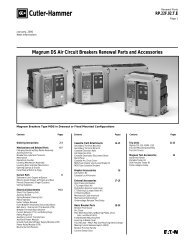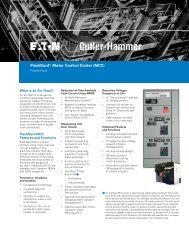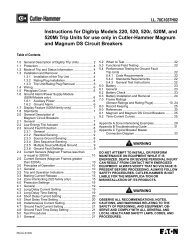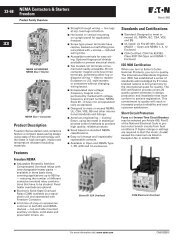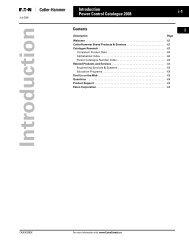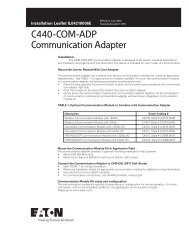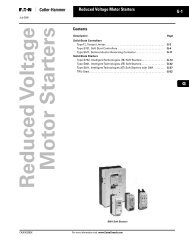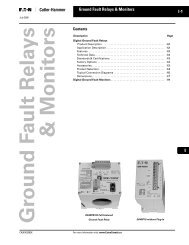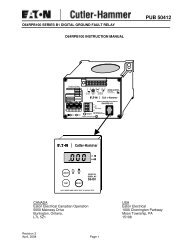M-Maxâ„¢ Series Adjustable Frequency Drive - Eaton Corporation
M-Maxâ„¢ Series Adjustable Frequency Drive - Eaton Corporation
M-Maxâ„¢ Series Adjustable Frequency Drive - Eaton Corporation
You also want an ePaper? Increase the reach of your titles
YUMPU automatically turns print PDFs into web optimized ePapers that Google loves.
Error and Warning Messages<br />
Error and Warning Messages<br />
Introduction<br />
M-Max frequency inverters have several internal monitoring<br />
functions. When deviations from the correct operating status<br />
are detected, faults (FAULT) and warning messages<br />
(ALARM) are differentiated between.<br />
Error Messages<br />
Faults can cause defective functionality and technical<br />
defects. The inverter (frequency inverter output) is<br />
automatically disabled if a fault is detected. After this, the<br />
connected motor comes to a stop freely.<br />
Error messages are shown on the display with an arrowhead<br />
under FAULT and with the error code F… (F1 = last fault,<br />
F2 = second to last, and so on).<br />
Example of an Error Message (Undervoltage)<br />
REF<br />
MON<br />
PAR<br />
FLT<br />
READY<br />
RUN STOP ALARM FAULT<br />
FWD REV I/O KEYPAD BUS<br />
Acknowledge Fault Message (Reset)<br />
The current error message flashes (for example, F1 09). It<br />
can be acknowledged by pressing the OK button followed by<br />
BACK/RESET or by actuating DI5 (default settings control<br />
signal terminal 15). The displayed error then automatically<br />
stops flashing, the four horizontal bars (Reset) are shown and<br />
the error message is then displayed continuously. The arrow<br />
point underneath FAULT disappears.<br />
WARNING<br />
If a start signal is present, the drive is restarted<br />
automatically, if P3.1 = 0 is set (REAF = Restart after<br />
FAULT) and the error message has been acknowledged<br />
(Reset).<br />
The current fault message indication (F1...) is cleared when<br />
the supply voltage is interrupted or when you press the OK<br />
button followed by BACK/RESET. The indication goes out<br />
and the arrow tip flashes at menu level MON.<br />
54 M-Max <strong>Series</strong> <strong>Adjustable</strong> <strong>Frequency</strong> <strong>Drive</strong> MN04020003E—April 2011 www.eaton.com<br />
Fault Log (FLT)<br />
The last nine faults can be called up and shown in succession<br />
in the fault log (FLT).<br />
Select the FLT menu level ( ). Use the arrow buttons and<br />
to call the faults F1–F9 individually. Every error message is<br />
stored with the time of the error occurrence under d (day), H<br />
(hour) and m (minute). The call is made with the OK button,<br />
and the selection with the and arrow buttons.<br />
The content of the error memory is cleared when the factory<br />
setting is activated. When you press the BACK/RESET<br />
button, the display of the menu level ( ) flashes and the<br />
STOP button is held down for around 5 seconds.<br />
Activating the factory settings will reset all parameters.<br />
Alarm Messages<br />
A warning message signals possible damage and indicates<br />
impending errors that can still be prevented, such as an<br />
excessively high temperature rise.<br />
Warning messages appear on the display with an arrow<br />
under ALARM and AL with the respective code number. The<br />
code numbers for faults and warning messages are identical.<br />
Example of an Alarm Message<br />
REF<br />
MON<br />
PAR<br />
FLT<br />
READY<br />
RUN STOP ALARM FAULT<br />
FWD REV I/O KEYPAD BUS<br />
If a warning message occurs, the frequency inverter remains<br />
active (READY, RUN).<br />
In the given example (AL 50 = current setpoint signal<br />
4–20 mA interrupted), the drive stops following the absence<br />
of a reference value. If no more measures are introduced<br />
because of the warning message (for example, a shutdown),<br />
the drive can start again automatically in the example AL 50<br />
when the current signal returns (for example, a contact fault<br />
in the signal line).<br />
The alarm message (AL) is displayed alternating with the<br />
active operational display value.<br />
The table on Page 55 shows the error codes, their possible<br />
causes, and indicates correction measures.




